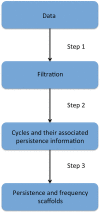Insights into Brain Architectures from the Homological Scaffolds of Functional Connectivity Networks
- PMID: 27877115
- PMCID: PMC5099524
- DOI: 10.3389/fnsys.2016.00085
Insights into Brain Architectures from the Homological Scaffolds of Functional Connectivity Networks
Abstract
In recent years, the application of network analysis to neuroimaging data has provided useful insights about the brain's functional and structural organization in both health and disease. This has proven a significant paradigm shift from the study of individual brain regions in isolation. Graph-based models of the brain consist of vertices, which represent distinct brain areas, and edges which encode the presence (or absence) of a structural or functional relationship between each pair of vertices. By definition, any graph metric will be defined upon this dyadic representation of the brain activity. It is however unclear to what extent these dyadic relationships can capture the brain's complex functional architecture and the encoding of information in distributed networks. Moreover, because network representations of global brain activity are derived from measures that have a continuous response (i.e., interregional BOLD signals), it is methodologically complex to characterize the architecture of functional networks using traditional graph-based approaches. In the present study, we investigate the relationship between standard network metrics computed from dyadic interactions in a functional network, and a metric defined on the persistence homological scaffold of the network, which is a summary of the persistent homology structure of resting-state fMRI data. The persistence homological scaffold is a summary network that differs in important ways from the standard network representations of functional neuroimaging data: (i) it is constructed using the information from all edge weights comprised in the original network without applying an ad hoc threshold and (ii) as a summary of persistent homology, it considers the contributions of simplicial structures to the network organization rather than dyadic edge-vertices interactions. We investigated the information domain captured by the persistence homological scaffold by computing the strength of each node in the scaffold and comparing it to local graph metrics traditionally employed in neuroimaging studies. We conclude that the persistence scaffold enables the identification of network elements that may support the functional integration of information across distributed brain networks.
Keywords: fMRI; functional connectivity; homological scaffold; integration and segregation; persistent homology.
Figures







References
-
- Bauer U., Lesnick M. (2014). Induced matchings of barcodes and the algebraic stability of persistence, in Proceedings of the Thirtieth Annual Symposium on Computational Geometry SOCG'14 (New York, NY: ACM; ), 355:355–355:364.
-
- Blondel V. D., Guillaume J.-L., Lambiotte R., Lefebvre E. (2008). Fast unfolding of communities in large networks. J. Stat. Mech. 2008, P10008–P10013. 10.1088/1742-5468/2008/10/P10008 - DOI
-
- Brandes U. (2001). A faster algorithm for betweenness centrality*. J. Math. Sociol. 25, 163–177. 10.1080/0022250X.2001.9990249 - DOI
Grants and funding
LinkOut - more resources
Full Text Sources
Other Literature Sources

